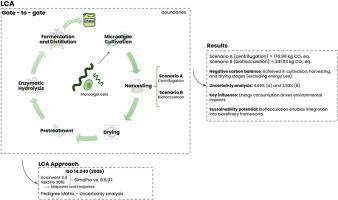微藻生物乙醇生产场景的生命周期分析
IF 5.8
2区 生物学
Q1 AGRICULTURAL ENGINEERING
引用次数: 0
摘要
目的通过生命周期评估(LCA)对螺旋藻生产生物乙醇的环境影响进行评价,比较了两种生物质收获方法:离心(情景A)和生物絮凝(情景B)。目的是确定哪种收获方法在生物燃料生产中提供最低的环境负担。方法采用LCA评价生物乙醇生产的各个阶段,包括培养、收获、干燥、预处理、酶解、酒精发酵和蒸馏。LCA数据来源于文献,使用SimaPro v. 9.5.0.1软件进行分析。采用ReCiPE方法对影响进行评估,重点关注全球变暖潜势(GWP)、陆地生态毒性(TET)和化石资源稀缺性(FRS)等类别。结果分析表明,情景B(生物絮凝)对环境的影响更大,其GWP值达到241.03 kg CO2 eq.,而情景A(离心)的GWP值为176.99 kg CO2 eq.然而,情景B的生物质收获效率更高(99.5%),使其更有效地产生有价值的生物制品。能量消耗对影响结果有显著影响,但排除能量后,在种植、收获和干燥阶段碳平衡为负。不确定性分析表明,情景A的变异性为4.69%,情景B的变异性为3.93%。结论:虽然生物絮凝(情景B)对环境的影响较大,但它能提高生物质收获的效率。研究结果强调了将生物质利用纳入生物炼制框架的重要性,以减少对环境的影响,并与生物乙醇生产中的可持续生物经济和循环经济战略保持一致。本文章由计算机程序翻译,如有差异,请以英文原文为准。

Life cycle analysis of microalgae bioethanol production scenarios
Purpose
This study evaluated the environmental impacts of bioethanol production from Spirulina platensis through Life Cycle Assessment (LCA), comparing two biomass harvesting methods: centrifugation (Scenario A) and bioflocculation (Scenario B). The aim was to determine which harvesting approach offers the lowest environmental burden in biofuel production.
Methods
The study used LCA to evaluate stages of bioethanol production, including cultivation, harvesting, drying, pre-treatment, enzymatic hydrolysis, alcoholic fermentation, and distillation. Data for the LCA were sourced from literature and analyzed using SimaPro v. 9.5.0.1 software. The impacts were assessed using the ReCiPE method, focusing on categories such as Global Warming Potential (GWP), Terrestrial Ecotoxicity (TET), and Fossil Resource Scarcity (FRS).
Results
The analysis showed that Scenario B (bioflocculation) had higher environmental impacts, with GWP reaching 241.03 kg CO2 eq., compared to Scenario A (centrifugation), which had 176.99 kg CO2 eq. However, Scenario B exhibited higher biomass harvesting efficiency (99.5 %), making it more effective for generating valuable bioproducts. Energy consumption significantly influenced the impact results, but excluding energy revealed a negative carbon balance in the cultivation, harvesting, and drying stages. Uncertainty analysis indicated variability of 4.69 % for Scenario A and 3.93 % for Scenario B.
Conclusions
The study concluded that while bioflocculation (Scenario B) presents higher environmental impacts, it offers greater efficiency in biomass harvesting. The findings emphasize the importance of integrating biomass utilization into biorefinery frameworks to reduce environmental impacts and align with sustainable bioeconomy and circular economy strategies in bioethanol production.
求助全文
通过发布文献求助,成功后即可免费获取论文全文。
去求助
来源期刊

Biomass & Bioenergy
工程技术-能源与燃料
CiteScore
11.50
自引率
3.30%
发文量
258
审稿时长
60 days
期刊介绍:
Biomass & Bioenergy is an international journal publishing original research papers and short communications, review articles and case studies on biological resources, chemical and biological processes, and biomass products for new renewable sources of energy and materials.
The scope of the journal extends to the environmental, management and economic aspects of biomass and bioenergy.
Key areas covered by the journal:
• Biomass: sources, energy crop production processes, genetic improvements, composition. Please note that research on these biomass subjects must be linked directly to bioenergy generation.
• Biological Residues: residues/rests from agricultural production, forestry and plantations (palm, sugar etc), processing industries, and municipal sources (MSW). Papers on the use of biomass residues through innovative processes/technological novelty and/or consideration of feedstock/system sustainability (or unsustainability) are welcomed. However waste treatment processes and pollution control or mitigation which are only tangentially related to bioenergy are not in the scope of the journal, as they are more suited to publications in the environmental arena. Papers that describe conventional waste streams (ie well described in existing literature) that do not empirically address ''new'' added value from the process are not suitable for submission to the journal.
• Bioenergy Processes: fermentations, thermochemical conversions, liquid and gaseous fuels, and petrochemical substitutes
• Bioenergy Utilization: direct combustion, gasification, electricity production, chemical processes, and by-product remediation
• Biomass and the Environment: carbon cycle, the net energy efficiency of bioenergy systems, assessment of sustainability, and biodiversity issues.
 求助内容:
求助内容: 应助结果提醒方式:
应助结果提醒方式:


